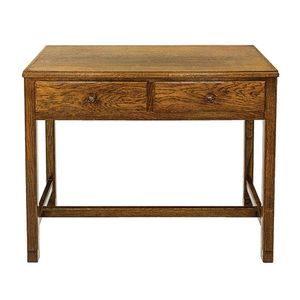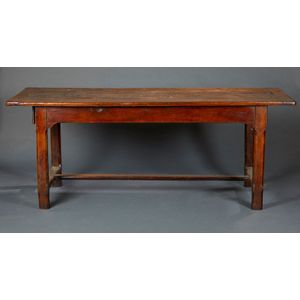French farmhouse table with drawers and H stretcher
You must be a subscriber, and be logged in to view price and dealer details.
Subscribe Now to view actual auction price for this item
When you subscribe, you have the option of setting the currency in which to display prices to $Au, $US, $NZ or Stg.
- Fruitwood - A catch-all term used to describe the wood of any of several fruit-bearing trees, such as the apple, cherry, or pear, used especially in cabinetmaking.
With a blond colour when finished, fruitwood was used in Europe, especially France, in the 18th and 19th centuries for larger items of furniture such as tables, chairs, cabinets and bookcases but in England its use was generally restricted to decorative elements such as inlays. - Bevel / Chamfer - In furniture making, a chamfered corner refers to a technique used to create a smooth, angled edge on the corner of a piece of furniture. This is typically done by cutting away a small portion of the corner at an angle, typically 45 degrees, creating a diagonal edge, rather than a sharp 90-degree angle. This technique can be used on various parts of a piece of furniture such as table legs, drawer fronts, or door frames. Chamfering can add visual interest to a piece and can help to soften the overall look of a piece of furniture. It is often used in conjunction with other techniques, such as rounding edges or using contrasting wood species to create a more elegant, sophisticated look. Chamfering is a simple way to add a touch of elegance to a piece of furniture and it is a common technique used by furniture makers.
- Stretcher - A horizontal rail which connects the legs of stools, chairs, tables and stands, to provide stabilisation of the legs. A stretcher table is any table with a stretcher base. The term is usually applied to substantial farmhouse tables, although many cabinetmaker's pieces, such as sofa tables, also have turned stretchers.
- Provenance - A term used to describe the provable history of an antique or work of art, and thus an additional aid to verifying its authenticity. Provenance can have an inflating effect on the price of an item, particularly if the provenance relates to the early settlement of Australia, a famous person, or royalty. Less significant are previous sales of the item through an auction house or dealer.
This item has been included into following indexes:
- tables, large dining
- tables, period or style - Georgian 159
Visually similar items

Georgian oak one drawer occasional table. 70 cm high, 93 cm wide, 55 cm deep

Two drawer French provincial chestnut side table, Likely 18th century and later, the drawers have turned drop handles supported on a 'H' stretcher type base. Height 75 cm. Width 110.5 cm. Depth 57 cm

An English pale oak provincial plank top rectangular side table, late 18th century. 75 cm high, 120 cm wide, 72 cm deep

Gordon Russell of Cotswolds England, two drawer desk/console table. Width 99 cm. Depth 55 cm. Height 81.5 cm
